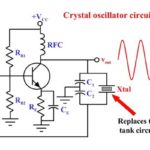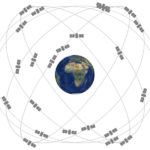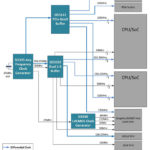Atomic clocks have shrunk from room-sized assemblies to PC-board mountable modules, admittedly with lower performance than their big siblings but still far better than crystal-based timing alternatives.
Atomic clocks are based on the transitions of energy states of specific elements such as cesium, ytterbium, rubidium, and others under specific and tightly controlled conditions. They are the absolute standard of time in meteorology. In the United States, the National Institute for Standards and Technology (NIST) developed, operates, and maintains NIST-F1, the nation’s primary time and frequency standard located in Boulder, Colorado. This cesium “fountain” atomic clock contributes to the international group of atomic clocks that define Coordinated Universal Time (UTC), the official world time.
In the SI (Système international- International System of Units) definition of base units, the second is defined by setting the fixed numerical value of the cesium frequency ΔνCs (the unperturbed ground-state hyperfine transition frequency of the cesium-133 atom) to be 9,192,631,770 when expressed in the unit Hertz (Hz, the reciprocal of seconds). Primary-standard atomic clocks require supercooled plumbing near absolute zero, lasers, optics, and electronics, as well as considerable operating power and attention, and occupy a large room (Figure 1).

Obviously, the NIST primary-standard arrangement isn’t practical as a component or system on a test bench or even a satellite in space. Nearly all satellites, whether in Earth orbit or deep space, carry an atomic clock; in fact, every satellite in the GPS constellation has one plus a backup. The availability of such clocks is key to the accuracy of the GPS-defined location functionality. The atomic clocks used in satellites are often customized versions of the secondary-standard atomic clocks that you can buy as a standard item from various instrumentation vendors.
For example, atomic clocks such as commercial rubidium frequency standards operate by phase-locking (called “disciplining”) a crystal oscillator to the hyperfine transition at 6.834,682,612 GHz in rubidium. The amount of light from a rubidium discharge lamp that reaches a photodetector through a resonance cell will drop by about 0.1 % when the rubidium vapor in the resonance cell is exposed to microwave power near the transition frequency. The crystal oscillator is stabilized to the rubidium transition by detecting the light dip while sweeping an RF frequency synthesizer (referenced to the crystal) through the transition frequency. (Atomic clocks based on cesium or other elements have some similarities in operating principles and significant differences – all too complicated to explore here.)
These secondary standards are used in satellites, Earth stations, major cellular and Internet backbones nodes, and even high-end test and measurement systems, with the 19-inch rack model being very common. While these rack-mount units have an accuracy which is many orders of magnitude than primary units such as NIST-F1, they are still far better, again by many orders of magnitude, than even the best crystal-controlled clock (oscillator), including high-end oven-controlled (OXCO) or medium-to-high performance temperature controlled (TXCO) units.
There are even smaller units, such as the Stanford Research Systems PRS-10, a rubidium-based atomic clock. It measures just 2.00″ × 3.00″ × 4.00″, weighs 1.32 pounds, requires +24 VDC/0.6 A in steady-state operation (after 2.2 A warm-up), and sells for about $2000, even though the complete unit requires a considerable amount of support circuitry (Figure 2).
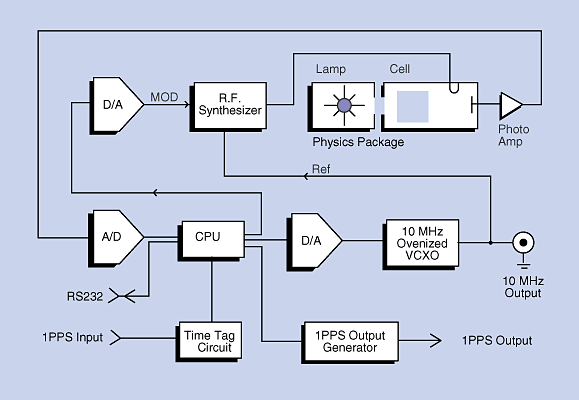
The physical construction of such a unit with its circuit boards around the rubidium core (Figure 3 and Figure 4) is critical to achieving compact packaging and reaching the highest level of potential performance, as thermal stability and uniformity play a large role.
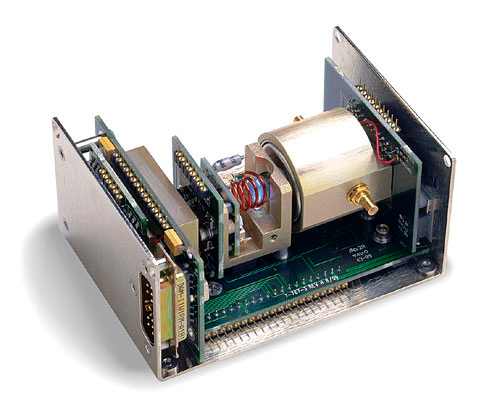

The next section will look at the development, design, and overall operation of the Chip-Scale Atomic Clock (CSAC), a standard commercial module from Microchip Technology which can be mounted on a PC board.
EE World Related Content
GPS is a ubiquitous and problematic technology
Basics of GPS receivers
GPS, Part 1: Basic principles
GPS, Part 2: Implementation
Atomic clock works from 5 V, outputs CMOS-compatible signals
Chip-scale atomic clock produces super-stable frequencies
Miniaturized rubidium atomic clock maintains high degree of synchronization to reference clock
Commercial space Chip Scale Atomic Clock module is radiation tolerant
Chip-scale atomic clocks fit in compact quarters
Quartz crystals and oscillators, Part 1: Crystal basics
Quartz crystals and oscillators, Part 2: Advanced crystals
References
- National Institute for Standards and Technology, “NIST-F1 Cesium Fountain Atomic Clock”
- National Institute for Standards and Technology, “Definitions of SI Base Units”
- National Institute for Standards and Technology, “Analysis of Time Domain Data” (Allan Deviation).
- Stanford Research Systems, “Rubidium Oscillator PRS10”
- Stanford Research Systems, “Frequency Standards: PRS10 — Rubidium frequency standard with low phase noise”
- Symmetricom, “The SA.45S Chip-Scale Atomic Clock”
- Wikipedia, “Allan variance.”
- Microchip Technology, CSAC SA65 Data Sheet
- Microchip Technology, “Chip-Scale Atomic Clock (CSAC) SA65 User’s Guide”
- Microchip Technology, Robert Lutwak, “Tactical Atomic Clocks”
- Lutwak, et al; 36th Annual Precise Time and Time Interval (PTTI) Meeting, “The Chip-Scale Atomic Clock – Low-Power Physics Package” (2004)
- Mescher, et al, “An Ultra-Low-Power Physics Package For a Chip-Scale Atomic Clock”
- 2011 Stanford PNT Symposium, Robert Lutwak, “The SA.45S Chip-Scale Atomic Clock”
- US Patent 6,927,636 B2 (2005), “Light stabilization for an optically excitable atomic medium”
- US Patent 6,320,472 B1 (2001), “Atomic Frequency Standard”
- US Patent 7,215,213 B2 (2007), “Apparatus and system for suspending a chip-scale device and related methods”



